

This will help to prevent the paint from being absorbed into the plaster, resulting in an uneven finish. When it comes to painting plaster walls, there are a few things to keep in mind.įirst, because plaster is a porous material, it’s important to use a primer before applying paint. What type of paint should I use on plaster walls? It can be painted or left natural, and it can be used to create a variety of different looks. Plaster also adds a unique aesthetic to any space. As a result, it’s an ideal material for use in both residential and commercial buildings. In addition to its aesthetic value, plaster also provides good soundproofing and insulation. Plaster walls and ceilings are often decorated with intricate designs or painted in bright colors. Plastering is a skilled trade that requires careful planning and execution. Once it dries, plaster hardens into a solid, yet flexible, surface making it an ideal material for both new construction and renovations.

When combined with water and other binders, these materials form a thick paste that can be applied to walls and ceilings. It is made from a variety of materials, including limestone, gypsum, sand, and clay. Plaster is a material that has been used for centuries to create smooth, durable surfaces. Here are some answers to common questions to help you along the way. Questions might arise while you are going through the process of painting your plaster walls. You can also wash your brushes and rollers with soap and water so they’re ready for next time! FAQ Once the paint is dry, you can remove the painter’s tape and put all of the furniture back in the room.īe sure to dispose of any leftover paint properly. You may need to do two coats of paint depending on the color you choose and how well it covers.Īllow the first coat of paint to dry completely before adding a second coat. If you see any imperfections then spackle, sand and paint those spots before you paint the whole wall. Have in mind that a less glossy paint finish will help to disguise any imperfections in the walls. Once that’s done, you can roll on the paint. Use the same technique as you did with the primer, beginning with cutting in around the edges.
PAINTING PLASTER WALLS PRO
Pro Tip: You can use a paintbrush with some paint on it, or dipped in water, to smooth out the caulk. If you have cracks in the corners then use a caulking gun with an acrylic latex caulk when the primer is dry. Once the cutting in is complete, you can use a roller on an extension pole to paint the rest of the wall. This means you will paint a 2-3 inch strip around the corners, ceiling, and baseboard. If the plaster is new, you’ll need to let it dry for 4-8 weeks, depending on thickness, before you prime the walls.īegin by cutting in around the edges of the wall with a 2- inch paintbrush.

This is an important step because it will help the paint adhere to the surface. Once the walls are smooth and dry, you will need to prime them. If not, sand with fine-grit sandpaper (120-150) until the walls feel smooth. Sand the spackled areas, if the walls feel smooth to the touch then you can move on to the next step. Allow the patches to dry completely before moving on to the next step. If there are large holes you can spackle with hot mud that doesn’t shrink much.
PAINTING PLASTER WALLS PATCH
Once the walls are cleared, you can patch any holes or cracks with putty or joint compound with the putty knife.
PAINTING PLASTER WALLS PROFESSIONAL
If the paint contains lead then either hire a professional to do the prep work for you or take all the necessary safety precautions to do it yourself. You can do this yourself with a lead test kit, or you can hire a professional to come and do it for you. If your walls were painted before 1978 then it’s important to check for lead levels before you start sanding or stripping the paint. You will want to open any curtains or blinds and turn on all the lights so you can see any imperfections in the walls that need to be addressed. Make sure you have the proper lighting in the room as well. If you have any electrical outlets, you will need to remove the covers or tape around them with painter’s tape. This means you will need to move all of the furniture out of the way and cover the floor with a tarp or drop cloths. The first step is always to prep the room before you start to paint your plaster walls. Do I need to mist coat old/new plaster?.What kind of primer should I use on plaster walls?.Do I need to sand the walls before I paint them?.



 0 kommentar(er)
0 kommentar(er)
